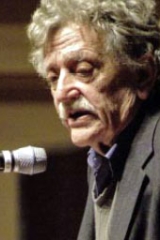
(1963), Slaughterhouse-Five
(1969) and Breakfast of Champions
(1973) blend satire
, gallows humor
and science fiction
. He was known for his humanist
beliefs and was honorary president of the American Humanist Association
.
Kurt Vonnegut, Jr. was born in Indianapolis
, Indiana
to third-generation German-American parents, Kurt Vonnegut, Sr. and Edith Lieber. Both his father and his grandfather Bernard Vonnegut
attended Massachusetts Institute of Technology
and were architects in the Indianapolis firm of Vonnegut & Bohn
.
I sometimes wondered what the use of any of the arts was. The best thing I could come up with was what I call the canary in the coal mine theory of the arts. This theory says that artists are useful to society because they are so sensitive. They are super-sensitive. They keel over like canaries in poison coal mines long before more robust types realize that there is any danger whatsoever.![]()
High school is closer to the core of the American experience than anything else I can think of.![]()
I was taught in the sixth grade that we had a standing army of just over a hundred thousand men and that the generals had nothing to say about what was done in Washington. I was taught to be proud of that and to pity Europe for having more than a million men under arms and spending all their money on airplanes and tanks. I simply never unlearned junior civics. I still believe in it. I got a very good grade.![]()
I was taught that the human brain was the crowning glory of evolution so far, but I think it’s a very poor scheme for survival.![]()
1. Find a subject you care about.2. Do not ramble, though.3. Keep it simple.4. Have the guts to cut.5. Sound like yourself.6. Say what you mean to say.7. Pity the readers.![]()
I urge you to please notice when you are happy, and exclaim or murmur or think at some point, "If this isn't nice, I don't know what is." ![]()

